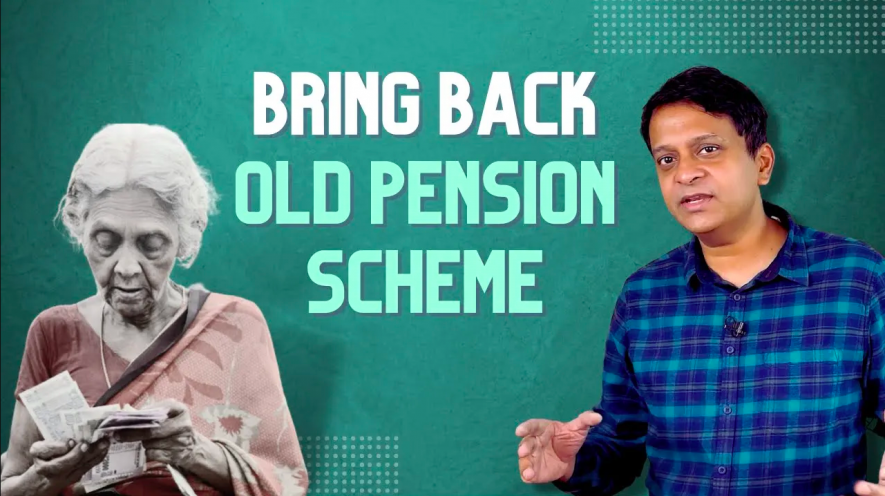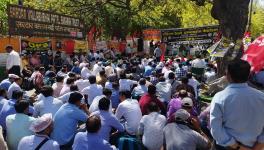Why it Makes Sense to Revive Old Pension Scheme

As many as 19 years ago, when Atal Bihari Vajpayee was Prime Minister, the NDA (National Democratic Alliance) government introduced a new pension system for retired government servants, called the National Pension Scheme or NPS. It was implemented in January 2004, but as you know, a few months later the NDA lost the elections and the Congress-led UPA (United Progressive Alliance) came to power.
Now, the Congress liked NPS so much that it implemented it in total and also nudged state governments to implement it. Only the Left opposed the new scheme and West Bengal refused to implement it.
What was this NPS and how was it different from the old pension scheme?
The old pension scheme, which has come to be called OPS, was pretty simple in design. Government employees get half of their last drawn salary as pension for the rest of their lives. So, if someone earned Rs 1 lakh just before retiring they would get 50,000 as pension after retirement every month.
Now, we know that government servants obviously don’t get paid as much as private sector employees do, but they are protected against inflation through a system of dearness allowance or DA, which is based on the current rate of inflation as it is revised twice a year.
For example, if the government announced 5% DA for the year, then a babu would get 5% of his Rs 1 lakh salary or Rs 5,000 as DA.
What about retired government employees?
Under the old system they too would be entitled to this 5% DA. So, after retirement, a government official, in our example, would get Rs 2,500 as DA on his Rs 50,000 pension.
Not only that, pensions in the old scheme were revised upward every 10 years or so to match changes in the standards of living in the country as a whole.
OPS was entirely funded by the government, the employees paid nothing for it. NPS changed that entirely. Government employees now had to
contribute 10% of their salaries toward the pension fund and the government, which was the employer, matched that contribution and sometimes paid even more. This corpus would be invested in bonds and stocks so that it could grow. Employees could choose from several different options of varying degrees of stock market exposure, depending on their own risk appetite.
The pension payout, therefore, depended on how well their corpus had performed. There was no DA nor any pension revision.
At the time the NPS was implemented, financial experts and economists had argued that government employees would end up with much bigger pensions compared with the old scheme because, they argued, equities or stocks always deliver higher returns. They also argued that the old pension scheme was not sustainable anymore, it was costing governments too much and eating up a large part of their revenues which could otherwise be used for development purposes.
Under NPS, governments still do have to pay a certain annual outgo in terms of the employer’s contribution to the pension corpus, but the liability is much lower than what it was under the old scheme.
Another feature of NPS is that it is open to everyone, not just government servants. Of course, governments don’t contribute anything toward a private employee’s pension fund but everyone gets tax benefits from investing in the NPS and also get their investments managed for free.
So, why have five state governments, all Opposition governments, gone back to the old system?
The reason is that government servants are realising that the benefits that were promised in 2004-05 had turned out to be blatant lies. Their monthly incomes are now dropping sharply as soon as they retire. In some cases, to less than 15% of what they were earning right before retirement.
When NPS was introduced, the pundits had argued, as I said, that people would end up with much higher pensions than what they could have got under the old system. That is because a part of their money was going to be invested in equities or stock markets, depending on which option they chose and equities have historically delivered much higher rates of return. So, therefore, the corpus would grow at a faster rate. But, as it turns out, the real returns on NPS investments have been much, much lower. On top of that, they’re fixed forever. Neither are these protected against inflation nor are these pensions revised periodically.
So, government employees have been agitating for a while, asking for the old pension scheme to be revived.
The Centre hasn’t budged at all, but Opposition states have. So now economists are saying that going back to the old system is economic anarchy. It will destroy the finances of state governments, which already spend a huge amount of their tax revenues on paying pensions to their employees. Many columns have been written about this, and I’m sure you’ve read a few of them.
Our estimates suggest that one-fourth of what states earn in taxes is spent on pensions. In some states, like Punjab and Himachal, which have ironically gone back to the old scheme, the expenditure is even higher. So, economists are saying that if OPS is revived, states will go bankrupt.
Now, how valid is this argument?
First of all, this is an accounting trick. A state’s revenue is not just what it collects in taxes. Because states have no access to half of the taxes generated in the economy, which is income tax and corporate tax, states get a portion of what the Centre collects. And that is what has to be counted as legitimate tax revenue.
Along with that, states also get various grants, which is due to them under India’s federal financial structure. If you add all of that, which are all the legitimate revenues of a state, pension payouts drop to less than 12% of the total revenues earned by states, not 25%.
It is true that pension payouts under the old system would have continued to rise because of two things. The first is inflation and pension revisions. And second, increased longevity of Indians, which means pensions would have to be paid for a longer period after retirement.
But, this can be covered by increasing tax revenues, especially by taxing the rich. As economists Rohit Azad and Indranil Chaudhary have shown us, India ranks at the bottom end amongst G20 countries when it comes to raising revenues to direct taxes.
Those two-thirds of the tax revenues in India come from indirect taxes, like GST (goods and services tax), excise duty, local taxes and customs. All economists agree that this is bad because the poor end up paying equally for indirect taxes, whereas direct taxes can be targeted at those who can afford to pay taxes.
The government can easily raise more resources by taxing corporates who have been making record profits since their tax rates were slashed four years ago.
Similarly, India is amongst the only big economies of the world which does not have any wealth tax, something that even big free market capitalist economies use to mobilise revenues. So, if the government has the will to tax the rich, it will have enough money to pay proper pensions to its employees.
But, there’s a bigger, moral and ethical argument here, one that deals with how we view citizens of the country. The discourse about the old pension scheme is dominated by neoliberal views, where the state is seen as an entity that has no responsibilities toward its citizens. The market is expected to decide who gets what. That is why the words used for pensions are ‘burden’ and ‘liability’.
We are also told by economists that government employees are a pampered lot. Why should they get pensions all their lives when other people don’t? Then why do these same economists, the same pundits not fight for government salaries to be the same as corporate salaries? Why don’t they want to pay market rates for the services that government employees provide to society? They’ll never do that.
Economists keep warning us that if the old pension scheme is revived, the young will have to pay for the old. But tell me what is wrong with that? Do human beings cease to exist as citizens once they can no longer work? Do we as a society not owe a decent life to those who work for decades for society as a whole? After all, that is precisely what government employees do. Even when they are corrupt and do it badly, without the edifice of the government economy, our society, everyday life simply cannot function. Democracy cannot function.
Retired people are not a burden. They deserve decent lives where they are protected against rising prices and are also guaranteed that the standards of living will keep pace with the rest of society as long as they are alive. The real reason why they are painted as a burden is because if pensions are made contributory, finance capital gets access to a huge corpus of public savings to deploy into the financial system for their own profits through financial speculation. And the contributors end up with nothing substantial as we’ve seen. That is why we must get the old pension system back, not only because retired people deserve better, but also because finance capital, which has already wrecked the global economy, needs to be resisted and stopped in its tracks.
Transcript of the video:
Aunindyo Chakravarty was Senior Managing Editor of NDTV India & NDTV Profit.He runs the YouTube channel Desi Democracy and anchors a bi-weekly show on Newsclick.
Get the latest reports & analysis with people's perspective on Protests, movements & deep analytical videos, discussions of the current affairs in your Telegram app. Subscribe to NewsClick's Telegram channel & get Real-Time updates on stories, as they get published on our website.
























